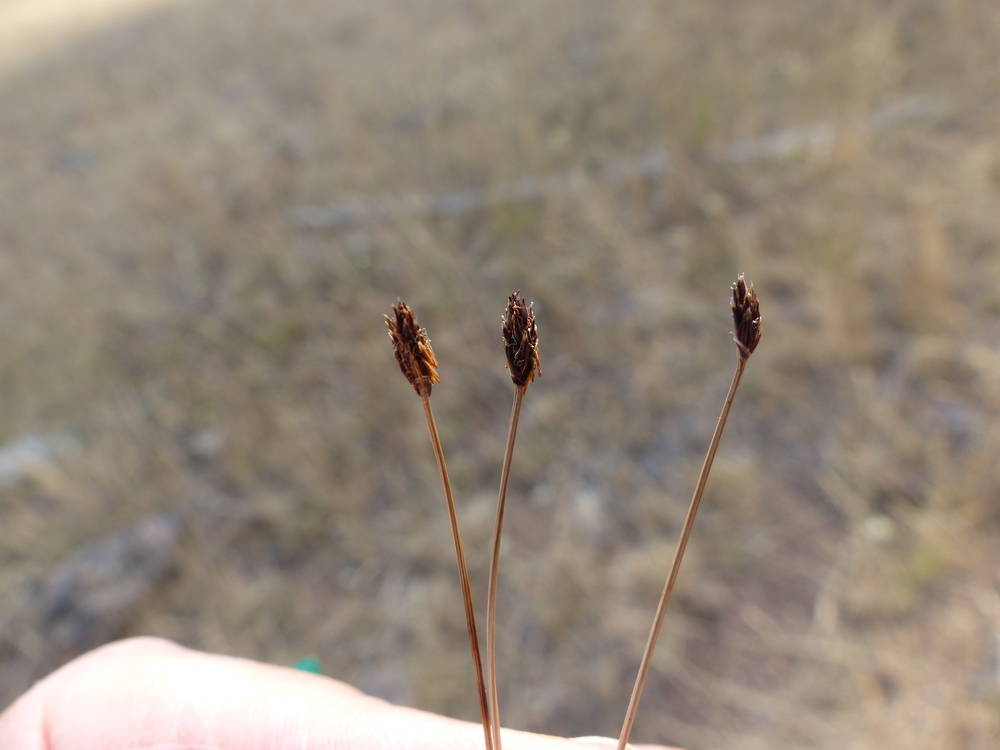Eleocharis bolanderi
Eleocharis quadrangulata
Bolander's spikerush
four-angled spikerush, square-stemmed spikerush
subterete, 10–30 cm × 0.3–0.5 mm.
acutely quadrangular; (30)45–105 cm × (1)2–5.4 mm.
ovoid, 3–8 × 2–3 mm;
proximal scale clasping; entire, subproximal scale with flower; floral scales 8–30, 4–5 per mm of rachilla, 2–3 × 1.5 mm;
apex entire; acute, often keeled in distal part of spike.
(15)20–76 × 3–5(6) mm;
proximal scale empty; amplexicaul; (1)2.2–5.4 mm; floral scales (28)45–135, 2–3 per mm of rachilla; (4)4.5–6.2 × 2.8–5 mm;
apex rounded to obtuse.
perianth bristles 3–6, often unequal; from rudimentary to 50% of achene length;
anthers 0.9–1.4 mm;
stigmas 3.
perianth bristles 6–7, often markedly unequal; shorter than achene or some equaling tubercle;
anthers 2.3–2.9 mm;
stigmas 3, sometimes 2.
slightly to greatly compressed-trigonous, rarely thickly lenticular, 0.9–1.2 × 0.65–0.8 mm.
biconvex, 1.8–3 × 1.3–2 mm; almost smooth to markedly sculptured at 10–15×; each face with 19–38 rows of almost linear, transversely elongated cells; which are sometimes isodiametric at achene base.
persistent, not splitting;
apex obtuse, rarely hardened, lacking a tooth.
persistent;
apex narrowly acute to acuminate, sometimes prolonged into a blade-like portion to 8 cm.
flat to shallowly pyramidal; lower than wide, 0.1–0.3 × 0.4–0.65 mm.
deltoid to high-pyramidal or lanceoloid, 0.7–1.5 × 0.4–1 mm, often spongy.
Eleocharis bolanderi
Eleocharis quadrangulata
Shallow, rocky, ephemeral streams. 1100–2100 m. BR, BW, Owy. CA, NV, ID; east to CO. Native.
Eleocharis bolanderi is easily recognized in summer when it forms masses of dry, brown, dormant and apparently dead culms in dry stream beds. It is easily pulled up to expose its cespitose habit. The virtually flat tubercles are particularly distinctive.
Shallow water of freshwater marshes, ditches, wet meadows, and lake shores. 100–200 m. WV. CA; south to Mexico; eastern North America. Exotic.
Eleocharis quadrangulata is a robust spikerush with long, pale spikes and rectangular culms.
Barbara Wilson, Richard Brainerd, Nick Otting
Barbara Wilson, Richard Brainerd, Nick Otting
- Local floras:
CA,
OR,
WA
- Local Web sites:
CalFlora,
CalPhotos,
Flora NW,
PNW Herbaria
WildflowerSearch
iNaturalist (observations)
USDA Plants Database
- LBJ Wildflower Center
- SEINet
- Plants of the World Online
- Encyclopedia of Life
- Wikipedia
- Google Image Search




